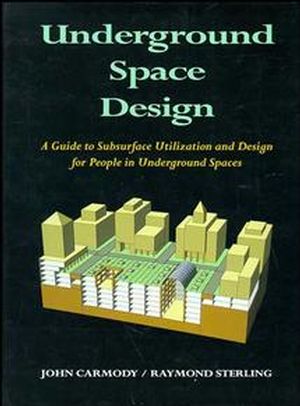Underground Space Design: Part 1: Overview of Subsurface Space Utilization Part 2: Design for People in Underground FacilitiesISBN: 978-0-471-28548-9
Paperback
340 pages
March 1993
 This is a Print-on-Demand title. It will be printed specifically to fill your order. Please allow an additional 10-15 days delivery time. The book is not returnable.
|
||||||
Underground space development may be one of the most significant
was to contend with urban predicaments such as congestion, lack of
open space, and aging infrastructures. However, designers must
consider whether or not people will be willing to live and work in
what could be perceived as inhospitable environments. Should people
be required to work in underground facilities, Or should
underground space be used solely for mechanical or transit services
and low-occupancy functions such as storage? What must designers do
to create subsurface spaces that will avoid or alleviate the
psychological and physiological problems associated with being
underground? Underground Space Design is the first comprehensive
book on subsurface space utilization throughout the world. The
authors supply a complete overview of the entire range of
underground uses by reflecting on the past, present, and future of
underground development. Underground Space Design is the result of
a five-year joint research study by the Underground Space Center at
the University of Minnesota and the Shimizu Institute of Technology
in Japan. This thorough, scholarly, and practical source offers
extensive coverage of the relevant topics including:
* an analysis of current underground land use
* the future of underground development
* comprehensive set of classifications
* a summary of existing research on psychological issues
* exterior and entrance design patterns
* layout and spatial configuration patterns
* interior design patterns
* methods of lighting
* life safety design patterns
Elaborately designed and illustrated, this book is the first complete source to present the broad range of underground design and uses, making it an ideal reference for architects, interior designers, civil engineers, geotechnical engineers, city planners, developers, and environmental psychologists. Underground Space Design is also an excellent introduction to the field, precisely serving the needs of students and other professionals.
* an analysis of current underground land use
* the future of underground development
* comprehensive set of classifications
* a summary of existing research on psychological issues
* exterior and entrance design patterns
* layout and spatial configuration patterns
* interior design patterns
* methods of lighting
* life safety design patterns
Elaborately designed and illustrated, this book is the first complete source to present the broad range of underground design and uses, making it an ideal reference for architects, interior designers, civil engineers, geotechnical engineers, city planners, developers, and environmental psychologists. Underground Space Design is also an excellent introduction to the field, precisely serving the needs of students and other professionals.



